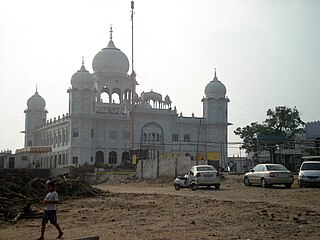
Guru Gobind Singh was the tenth and last human Sikh Guru. He was a warrior, poet, and philosopher. In 1675, at the age of nine he was formally installed as the leader of the Sikhs after his father Guru Tegh Bahadur was executed by Emperor Aurangzeb. His father was the ninth Sikh Guru. His four biological sons died during his lifetime – two in battle and two executed by the Mughal governor Wazir Khan.

Dal Khalsa was the name of the combined military forces of 11 Sikh misls that operated in the 18th century (1735–1799) in the Punjab region. The military force was established by Nawab Kapur Singh in the mid 1730s.

Anandpur Sahib, also referred simply as Anandpur, is a city in Rupnagar district (Ropar), on the edge of Shivalik Hills, in the Indian state of Punjab. Located near the Sutlej River, the city is one of the most sacred religious places in Sikhism, being the place where the last two Sikh Gurus, Guru Tegh Bahadur and Guru Gobind Singh, lived. It is also the place where Guru Gobind Singh founded the Khalsa Panth in 1699. The city is home to Takhat Sri Kesgarh Sahib, the third of the five Takhts in Sikhism.

Bhai Mani Singh was an 18th-century Sikh scholar and martyr. He was a childhood companion of Guru Gobind Singh and took the vows of Sikhism when the Guru inaugurated the Khalsa in March 1699. Soon after that, the Guru sent him to Amritsar to take charge of Harmandir Sahib, which had been without a custodian since 1696. He took control and steered the course of Sikh destiny at a critical stage in Sikh history. He was also a teacher of the Gianian Bunga, later becoming known as the "Amritsari Taksal", currently located in Sato Ki Gali.

Rupnagar district is one of twenty-two districts in the state of Punjab, India. The city of Rupnagar is said to have been founded by a Raja called Rokeshar, who ruled during the 11th century and named it after his son Rup Sen. It is also the site of an ancient town of the Indus Valley civilization. The major cities in Rupnagar District are Morinda, Nangal and Anandpur Sahib. Morinda is also known as Baghwāla "[The City] of Gardens." Morinda is located on the Chandigarh-Ludhiana Highway. The Bhakra Dam in Nangal lies on the boundary with the neighboring state of Himachal Pradesh. Dadhi is one of the most important villages of the district, particularly because of Gurudwara Sri Hargobindsar Sahib.

Ajit Singh, also referred to with honorifics as Sahibzada Ajit Singh or Baba Ajit Singh, was the eldest son of Guru Gobind Singh and the son of Mata Sundari. His younger brothers were Jujhar Singh, Zorawar Singh and Fateh Singh, but they had been born to Mata Jito. He was killed in the Second Battle of Chamkaur along with his brother Jujhar Singh. His other two brothers, Zorawar Singh and Fateh Singh, nine and seven years old, respectively, were bricked alive at Fatehgarh Sahib on order of Wazir Khan, governor of Sirhind-Fategarh.
Nadaun is a historical town and a nagar panchayat in the Hamirpur district of Himachal Pradesh, India. Previously a part of the princely state of Kangra, Nadaun is presently an independent small town located on NH 3 and NH 303 in the Sivalik range foothills. It is situated on the banks of the Beas.

Nada Sahib is a Sikh gurudwara in the Panchkula district of the Indian state of Haryana. Situated on the banks of the Ghaggar-Hakra River in the Sivalik Hills of Panchkula, it is the site where Guru Gobind Singh Ji halted while travelling from Paonta Sahib to Anandpur Sahib after the Battle of Bhangani in 1688.
The Battle of Bhangani was fought between Guru Gobind Singh's army and Bhim Chand (Kahlur) of Bilaspur on 18 September 1686 or 1688, at Bhangani near Paonta Sahib. An alliance of Rajput Rajas of the Shivalik Hills participated in the engagement on behalf of Bhim Chand of Bilaspur State's side, including the states of Garhwal and Kangra. It was the first battle Guru Gobind Singh, the tenth Sikh Guru, fought at the age of 19.
The Battle of Anandpur was fought at Anandpur, between the armies of the Sikh Guru Gobind Singh and the Mughal forces aided by the Nawab of Bahawalpur state, Rajas of the Sivalik Hills.

The second siege of Anandpur, also known as the second battle of Anandpur (1704), was a siege at Anandpur, between Sikhs and the Mughal governors, dispatched by Aurangzeb, Wazir Khan, Dilwaar Kahn and Zaberdast Khan, and aided by the vassal Rajas of the Sivalik Hills which lasted from May 1704 to 19th December 1704.

The Saka Sirhindor the Chhotte Sahibzada Saka refers to the killing and martyrdom (Shaheedi) of the two sons of Guru Gobind Singh, named Zorawar Singh and Fateh Singh. The two Sikh children are remembered as the Chhotte Sahibzade. They are believed to have attained martyrdom on 26 December 1704 at the ages of 5(or 6) and 9 respectively. In remembrance of this occasion, the Shaheedi Jor Mela is organised annually at Fatehgarh Sahib Punjab, India, to commemorate the supreme sacrifice at the place of their martyrdom on the 24th to 26th of December.
Battle of Anandpur can refer to:
The Battle of Nirmohgarh was fought between Sikhs and the Mughal Empire in 1702.
The first siege of Anandpur was a thirty-five-day-long siege at Anandpur led by the Rajas of the Sivalik Hills and the Gujar and Ranghar tribesmen against the armies of the Sikh under Guru Gobind Singh.
The Battle of Guler was fought between forces led by Sikh Guru Gobind Singh and Mughal forces, aided by the Rajas of the Sivalik Hills.
The Battle of Anandpur was fought on 24 February between the Sikh forces led by Guru Gobind Singh and the forces of some Hill States.
The Battle of Anandpur (1685) was fought between the Sikhs and an allied force of rajas of the Hill States of the Sivalik range, specifically Kahlur, Kangra, and Guler.
The Battle of Bilaspur was fought in 1711 by Sikh forces led by Banda Singh Bahadur and the Rajas of Sivalik Hills led by Raja Ajmer Chand of Princely State of Kahlur (Bilaspur).
The Battle of Nadaun was fought in August 1752 by the Mandi and Guler state led by the Rajas of the states and the Mughal Empire led by Aziz Khan, the steward of Mir Mannu. The Hill States were supported by the Sikhs led by Jassa Singh Ahluwalia.







